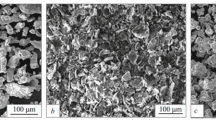Abstract
The surface melting of cast irons is discussed with particular emphasis on composition and effect of impurities. The hardness and wear properties are outstandingly good as shown from tracks under normal working conditions.
Similar content being viewed by others
References
Witzemann, private communication
F.H. Reinke, “Local Electric Arc Remelting Process for the Generation of Wear-Resistant White Iron Layers on Workpieces of Grey Cast Iron, especially Camshafts and Camfollowers”, AEG Elotherm, Remscheid, FRG, 1985
K. Heck, “Local Arc Remelting for the Generation of Wear Resistant White Iron Layers on Grey Cast Iron Camshafts” Wela, Moskau, 1977
F. Emde, Elektrowärme International, 37, B3 (1979)
H.W. Bergmann, Surface Engineering Vol. 1 No2, 137 (1985)
H.W. Bergmann, Proc. Conf. on Laser Surface Treatment of Metals, San Miniato, Italy, 1985, to be published
H.W. Bergmann, Int. Conf. on Foundry and Heat Treatment, Johannesburg, 1985, to be published
Acknowledgement
The work was largely supported by the Volkswagen Foundation. The authors are indebted to Prof. Krause, TU Aachen, for carrying out the wear measurements.
Author information
Authors and Affiliations
Rights and permissions
About this article
Cite this article
Mordike, B.L., Bergmann, H.W. Properties of Surface Melted SG Iron. MRS Online Proceedings Library 58, 429–435 (1985). https://doi.org/10.1557/PROC-58-429
Published:
Issue Date:
DOI: https://doi.org/10.1557/PROC-58-429




